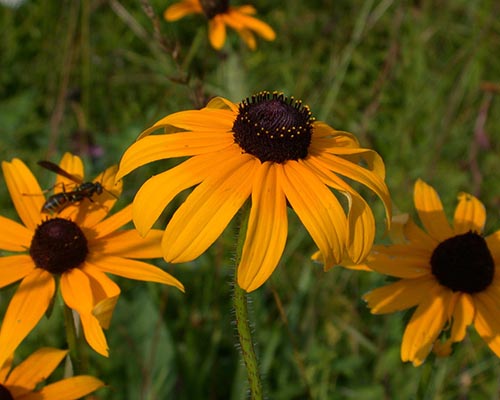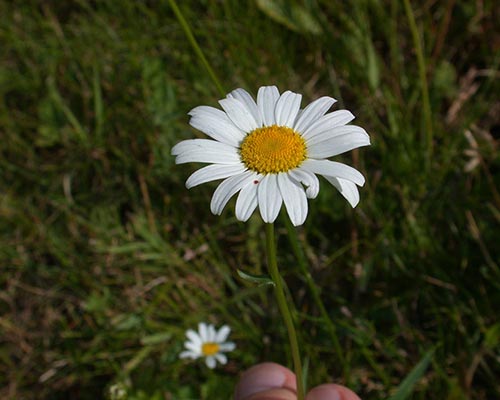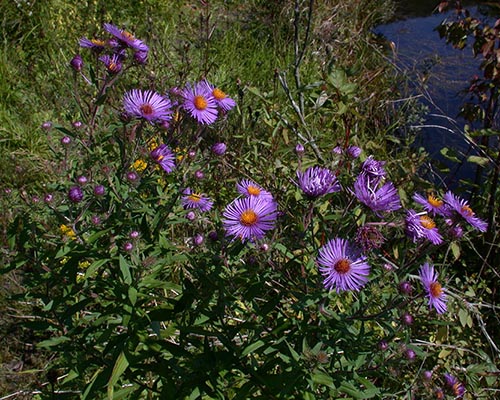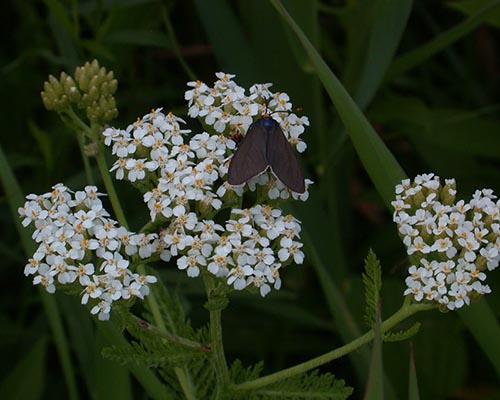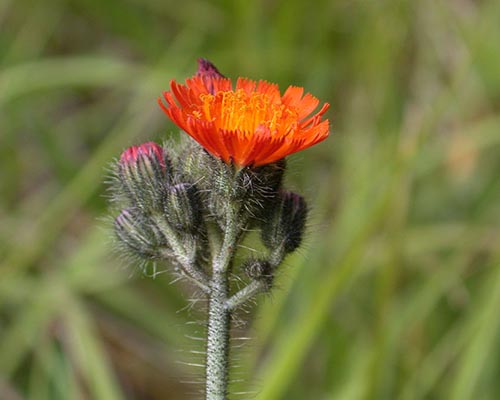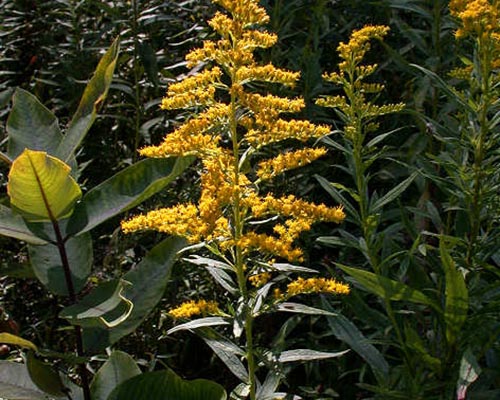While some flowers are adapted to blooming early in the spring (see the Spring Wildflowers station), the flowers at this station tend to bloom later in the year. Late-blooming wildflowers tend to be adapted to sunnier conditions in meadows, fields and prairies, where trees do not overshadow them. These wildflowers are thus often early colonizers of open sites, replaced by other species as succession progresses (see the Succession station).
Black-eyed Susan (Rudbeckia hirta) is a member of the Asteraceae (daisy) family. It has composite flowers. What appears to be a single flower is in fact a cluster of many flowers tightly packed together. The Latin hirta is related to the English “hirsute” and refers to the hairs that cover its leaves and stem. Black-Eyed Susan is commonly cultivated and attracts butterflies.
Ox-eye daisy (Leucanthemum vulgare) is also in the Asteraceae. The “petals” — actually ray flowers — of this composite flower are white, and the “head” — actually a mass of disc flowers — is yellow. It is not native to North America, but it is very difficult to eradicate since it can regenerate from fragments of the rhizomes that connect individual plants.
New England aster or Michaelmas daisy (Symphyotrichum novae-angliae), also in the Asteraceae, complements the color schemes of the previous two species. Its blooms are typically a shade from pink to deep purple but can be white. Gardeners have introduced this species to many areas due to its attractive flowers; it was brought to Europe in 1710 and is now widespread there.
Yarrow (Achillea millefolium) is also in the Asteraceae, a very large group with more than 23,000 species. Yarrow is popular in gardens since it attracts not only butterflies, but also predatory wasps and ladybirds that control insect pests. It has long been used medicinally, in many different ways. The dried aromatic leaves can be used to make a bitter tea, used as a cold remedy. Applied topically to wounds, it is said to staunch the flow of blood. In fact, according to Homer, Achilles carried yarrow into battle at Troy to heal wounds — thus the genus name Achillea, as well as its common names sanguinary and soldier’s woundwort. It has also been used to make liquors, bitters and beer.
Orange hawkweed, fox-and-cubs, or devil’s paintbrush (Pilosella aurantiaca), another Asteraceae member, is a non-native plant here. It was introduced as an ornamental plant in gardens because of its showy flowers and then escaped into the wild, where it is now widespread and can be invasive in some areas. It is designated as a noxious weed in several Western states.
The goldenrods (Solidago spp.) are a genus of wildflowers in — you guessed it — the Asteraceae. Goldenrod species can be rather difficult to tell apart, even for experts. Two rare and Threatened species of goldenrod are in the Adirondacks (S. simplex var. monticola and S. leiocarpa), but you are much more likely to see one of perhaps 60 more common species, such as Canada goldenrod (S. canadensis). Goldenrod is often blamed for allergies that are actually due to ragweed (Ambrosia spp.), also a composite but with wind-dispersed pollen that travels to our noses. Goldenrod pollen is too heavy and sticky to travel far in the wind. Herbal tea can be made from goldenrod, and honey from it is very light and spicy. Goldenrods are generally native to North America but have become invasive species in Europe (see the Non-Native Species station for more on this topic).
All of the flower species mentioned above are members of the Asteraceae family, which is one of the largest and fastest evolving families of flowering plants. All members of this family produce composite flowers.

